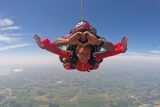From Fear to Fearless
Skydiving Tips
Posted by: Wisconsin Skydiving Center 7 years ago
As a new skydiver, you’re about to make the journey from total fear of the unknown to intelligently managed risk. That journey necessarily includes several stops along the way, among them: a practical education on your parachute and your procedures, wise counsel in managing your emotions and the solid mentorship that will feed your confidence. While fear mounts a mighty challenge, take heart–once you learn about fear’s true role, you’ll be much better equipped to scale the wall it builds between you and your skybound dreams.
FEAR IS IMPORTANT.
Let’s face it: If you’re in a dangerous situation and you aren’t in a heightened state of arousal, you’re kinda useless. You’re certainly not demonstrating the survival skills that nature evolved over aeons to keep you and your pulse united. Physiologically, the fear response quickens your responses to potentially dangerous inputs and helps you do what you need to do to stay alive and uninjured–so love your fear. It’s there for you when nothing else will do.

FEAR MOTIVATES.
Scared? Good. Use it. You can use your fear as gas in the tank. Let it motivate you to ask questions; to build skills, to actively seek out the mentorship of experienced athletes; to sign up for that canopy course; to dirt dive that jump until you can do it in your sleep. Listen to the fear when it tells you you’d better work on improving your battle plan; it’s right.
TAILORING YOUR FEAR IS A KEY LIFE SKILL.
Not all fear is the same. There’s the healthy kind–described above–and there’s the paralyzing kind. Luckily, your conscious responses can keep fear from veering into that problematic territory. Outside of the fear-inducing context, work on breathing exercises that you can go back to when you’re facing that monster on the battlefield. (Hot tip: There’s a GIF for that.)
FEAR IS PLIABLE.
Since fear is so physical, we have to learn not to let the wild horses of our bodies carry us away. To be successful, we have to learn how to control our physical responses enough that we’re not overwhelmed by them and are able to think clearly despite their presence. Fear flexes and responds to our conscious decision to slow down. (The trick is to make the conscious decision to slow down.)

FEAR IS A PARTNER IN THIS PROCESS.
If you’re too scared–scared enough that your conscious decision to slow down and breathe just doesn’t want to work–then your fear is probably telling you to stop what you’re doing. When that’s the signal you get, you can rest assured that it’s something you really need to listen to. Set aside your ego and take enough steps backward in the process that your fear stops giving you that signal. When you’re ready to press forward, you’ll know–and you’ll be glad you heeded your body’s brake lights.
We’re fear-management experts at the Wisconsin Skydiving Center, and we’re looking forward to helping you navigate the territory of your emotional relationship to the sport. Blasting through your fear will help you achieve your long-held dreams, and nothing excites us more than seeing that transformation take hold!
Categories:
You May Be Interested In:

23 of the Best Skydiving Quotes and Captions for Social Media
5 months ago by Wisconsin Skydiving Center

What Is Swooping In Skydiving?
6 months ago by Wisconsin Skydiving Center

Why is Starting Out Tandem Skydiving a Good Idea?
1 year ago by Wisconsin Skydiving Center

Should You Tip Your Skydiving Instructor?
1 year ago by Wisconsin Skydiving Center